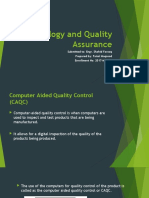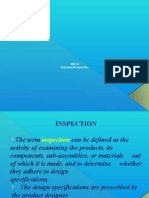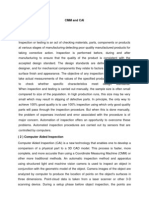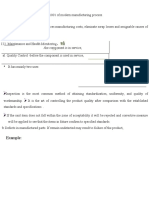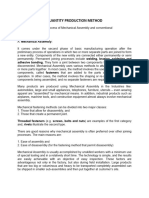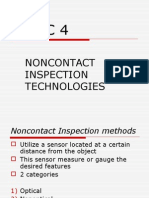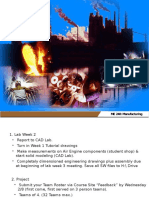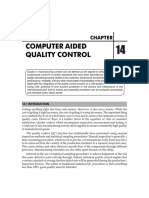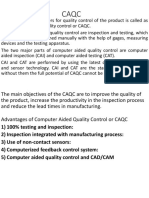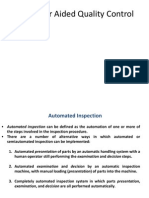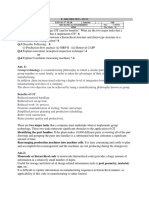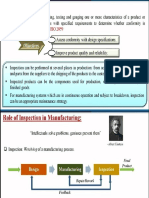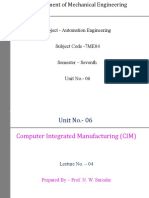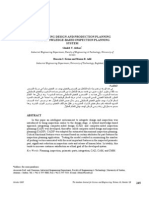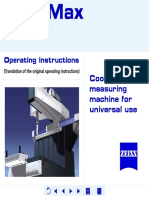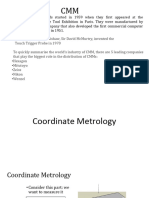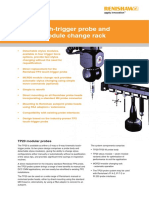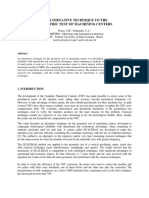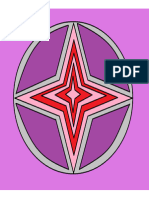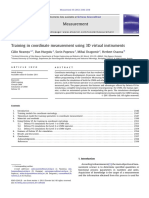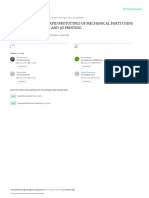CAD/CAM
UNIT – V
Syllabus :
Computer Aided Quality Control: Role of Computers in QC, difference between the
inspection and testing, advantages of CAQC, contact inspection method – coordinate measuring
machine, noncontact inspection method – machine vision, scanning laser beam technique.
Driving Technologies of Industry 4.0: Industrial Internet of Things (IIoT), Cobotics, 3D
Printing and Big Data Analytics.
Course objectives:
To present the role of computers and technology that drives the modern industry.
Course outcomes:
Upon successful completion of the chapter, the students will be able to
propose trends in manufacturing to improve productivity.
The Computer in QC:
Computer-aided inspection (CAI) and computer-aided testing (CAT) are merely extensions of
their counterparts described above, where as these activities have traditionally been performed
manually (with the help of gages. measuring devices. and testing apparatus); CAl and CAT are
performed automatically using the latest computer and sensor technology. Computer-assisted
inspection and testing methods form only part, certainly a major part, of computer-aided quality
control. In our treatment of the subject we shall include the integration of the quality control
function with CADCAM as a critical ingredient in the success of CAQC. CAI and CAT are
examples of what have been called "islands of automation." They are stand-alone systems.
Without their integration into larger computerized systems, CAQC will not achieve its full
potential.
The implications of the use of computer-aided quality control are important. The automated
methods of CAQC will result in significant changes from the traditional concepts and methods
described above. Critical changes will also occur in the way the quality function is implemented
within a company. We have already alluded to some of the changes. The following list will
summarize the important effects likely to result from CAQC.
�1. With CAI and CAT, inspection and testing will typically be accomplished on a 100% basis
rather than by the sampling procedures normally used in traditional QC.
2. Inspection during production will be integrated into the manufacturing process rather than
requiring that the parts be taken to some inspection area. This will help to reduce the elapsed
time to complete the parts. Also, to incorporate on- line inspection into the production
process will mean that inspection will have to be accomplished in much less time than with
current manual techniques. How will this improvement in inspection productivity be
achieved? The third point below addresses this question.
3. The use of noncontact sensors will become much more widely used with computer-aided
inspection. With contact inspection devices, the part must usually be, topped and often
repositioned to allow the inspection device to be applied properly. Stopping, repositioning,
and making physical contact with the part all take time. With noncontact sensor devices, the
part can often be inspected "on the fly.” These devices, driven by the high-speed data
processing capability of the computer, can complete the inspection in a small fraction of a
second. This is a rate which is certainly compatible with most production operations.
4. The on-line noncontact sensors will be utilized as the measurement component of
computerized feedback control systems. These systems will be capable of making
adjustments to the process variables based on analysis of the data collected by the sensors.
The data analysis would include statistical trend analysis. An example of the need for trend
analysis can be found in the gradual wear of cutting tools in a machining operation Data
would he plotted (even if only computer memory) on a control chart. This would not only
allow out-of-tolerance conditions to be identified, but gradual shifts in the process could also
be uncovered and corrective action taken. By regulating the process in this manner, parts will
be made much closer to the desired nominal dimension rather than merely within tolerance.
Quality feedback control systems will help to reduce scrap lou.eh and improve product
quality.
5. Because 100% inspection and on-line quality control system will become prevalent a basic
assumption in statistical QC must be challenged that is the assumption that anything less than
100% good quality is acceptable. The use of statistical quality control tolerates less than
100% perfect quality. With computer aided inspection (technology). It may m, longer be
necessary to settle for less than perfection.
�6. Sensor technology will not be the only manifestation of automation in CAQC. Robot will be
used increasing in future inspection application. Also, completely automated test cells, will
become an important component in future factories.
7. In addition to CAI and CAT, the computer will be used in other areas of quality control.
There will also be applications for the computer in quality assurance as well as QC. The
CAD/CAM data base will be used to derive these various quality applications.
There will be personnel implications CAQC to the extent that CAI and CAT rake its place.
Manual inspection activity will be reduced. Quality control personnel will have to become more
computer wise and technologically sophisticated to operate the more complex inspection and to
manage the information that will result from these mares automated.
Inspection Vs Testing:
A final distinction that should be made is the difference between inspection and testing.
Inspection is normally used to examine a component of a product in relation to the design
standards specified for it. For a mechanical component, this would probably concerned with the
dimensions of the part. These might be checked with several go/no go gauges or they might be
measured with a micrometer and other instruments. The common situations that warrant
inspection are:
Incoming raw materials
At various stages during manufacturing
At the completion of processing of the parts
Before shipping the final assembled product to the customer.
Testing is normally associated with the functional aspects of the item, and it is often directed at
the final product rather than its components. In this usage, testing consists of the observation of
the final product during operation under actual or simulated conditions. If the product passes the
test, it is deemed suitable for sale. Harrington lists several categories of tests used for final
product evaluation:
Simple functional tests under normal or simulated normal operating conditions.
Functional tests in which the product is tested under extreme conditions.
Fatigue or wear tests to determine how long the product will function until failure.
Overload tests to determine the level of safety factor built in to the product.
� Environmental testing to determine how well the product will perform under different
environments.
Another type of testing is often mentioned is destructive testing. This is a procedure that results
in the destructive of the item in order to measure the property of interest. A common example is
testing of specimen of metal to determine the metals strength and ductility properties.
Classification of Inspection Technologies:
The inspection technologies are classified based on the contact between the device and
workpiece during the process of inspection. This is presented below:
1. Contact Inspection Methods
a. Coordinate Measuring Machine
2. Non Contact Inspection Methods
a. Optical Techniques
i. Machine Vision
ii. Scanning Laser Beam Technique
b. Non Optical Techniques
i. Electrical Field Techniques
ii. Radiation Techniques
iii. Ultrasonic’s
Contact Inspection Methods:
Coordinate Measuring Machine (CMM):
Coordinate Measuring Machine (CMM) is a 3-dimensional measuring device that uses a contact
probe to detect the surface of the object. The probe is generally a highly sensitive pressure
sensing device that is triggered by any contact with a surface. The linear distances moved along
the 3 axes are recorded, thus providing the x, y and z coordinates of the point. CMMs are
classified as either vertical or horizontal, according to the orientation of the probe with respect to
the measuring table.
� Figure: Coordinate Measuring Machine
Mechanical Structure:
There are various physical configurations for achieving the motion of the probe each with
advantages and disadvantages.
a. Cantilever
b. Moving Bridge
c. Fixed Bridge
d. Horizontal Arm
e. Gantry
f. Column
� Figure: Six Types of CMM constructions
Advantages of CMM:
1. Reduced cycle time
2. Flexibility
3. Reduced operating errors
4. Greater inherent accuracy and precision
5. Avoidance of multiple setups.
Non Contact Optical Inspection Methods:
Machine Vision:
Machine vision is the acquisition of image data, followed by the processing and interpretation of
these data by computer for some useful application. The operation of a machine vision system
can be divided into the following three functions:
1. Image acquisition and digitization
2. Image processing and analysis
3. Interpretation
� Figure: Basic functions of a machine vision
Image Acquisition and Digitization:
Image acquisition and digitization is accomplished using a video camera and a digitizing system
to store the image data for subsequent analysis. The camera is focused on the subject of interest,
and an image is obtained by dividing the viewing area into a matrix of discrete picture elements
(pixels), in which each element has a value that is proportional to the light intensity of that
portion of the scene. The intensity value for each pixel is converted into its equivalent digital
value by an ADC (Analog to Digital Converter). The operation of viewing a scene consisting of
a simple object that contrasts substantially with its background, and dividing the scene into a
corresponding matrix of picture elements.
Each set of digitized pixel values is referred to as a frame. Each frame is stored in a computer
memory device is called a frame buffer. The process of reading all the pixel values in a frame is
performed with a frequency of 30 times per second.
� Figure: Dividing the image into a matrix of pixels (a) the scene (b) 12 x 12 matrix super imposed on the scene
Image Processing and Analysis:
The second function in the operation of a machine vision system is image processing and
analysis. The data for each frame must be analysed within the time required to complete one scan
(typically 1/30 sec). A number of techniques have been developed for analyzing the image data
in a machine vision system. One category of techniques in image processing and analysis is
segmentation. Segmentation techniques are intended to define and separate regions of interest
within image. Two of the common segmentation techniques are thresholding and edge detection.
Thresholding involves the conversion of each pixel intensity level into a binary value,
representing either white or black. This is done by comparing the intensity value of each pixel
with a defined threshold value. If the pixel value is greater than the threshold, it is given the
binary bit value of white, say 1; if less than the defined threshold then it is given the bit value of
black, say 0. Reducing the image to binary form by means of thresholding usually simplifies the
subsequent problem of defining and identifying objects in the image. Edge detection is
concerned with determining the location of boundaries between an object and its surroundings in
an image. This is accomplished by identifying the contrast in the light intensity that exists
between adjacent pixels at the borders around the object.
� Figure: Pixel Intensity values, either black or white, for the scene
Interpretation:
For any given application, the image must be interpreted based on the extracted features. The
interpretation function is usually concerned with recognizing the object, a task termed object
recognition or pattern recognition. The objective in these tasks is to identify the object in the
image by comparing it with predefined models or standard models. Two commonly used
interpretation technique are template matching and feature weighting. Template matching is the
name given to various methods that attempt to compare one or more features of an image with
the corresponding features of a model or template stored in computer memory.
Feature weighting is a technique in which several features (e.g., area, length, and perimeter) are
combined into a single measure by assigning weight to each feature according to its relative
importance in identifying the object. The score of the object in the image is compared with the
score of an ideal object residing in computer memory to achieve proper identification.
Laser Systems:
The unique feature of a laser (laser stands for Light amplification by stimulated emission of
radiation) is that it uses a coherent beam of light that can be projected with minimum diffusion.
Because of this feature, lasers have been used in a number of industrial processing and
measuring applications. High-energy laser beams are used for welding and cutting of materials,
and low-energy lasers are utilized in various measuring and gauging situations.
The scanning laser device falls into the latter category. The scanning laser uses a laser beam that
is deflected by a rotating mirror to produce a beam of light that can be focused to sweep past an
object. A photo detector on the far side of the object senses the light beam except for the time
period during the sweep when it is interrupted by the object, This time period can be measured
with great accuracy and related to the size of the object in the path of the laser beam, The
�scanning laser beam device can complete its measurement in a very short time. Hence, the
scheme can be applied in high-production online/post-process inspection or gauging, a
microprocessor counts the time interruption of (he scanning laser beam as it sweeps past the
object, makes the conversion from time to a linear dimension, and signals other equipment to
make adjustments in the manufacturing process and/or activate a sortation device on the
production line. Applications of the scanning laser technique include rolling mill operations, wire
extrusion, and machining and grinding processes.
Figure: Diagram of Scanning Laser Device
More sophisticated applications of laser inspection systems are found in the automotive
industry for measuring the contour and fit of car bodies and their component sheet metal parts.
These applications require very large numbers of measurements to be taken in order to capture
the shapes of complex geometric contours. Tolinski describes three components in the inspection
systems that perform these measurements. The first is a laser scanner capable of collecting more
than 15.000 geometric data points per second. The second component is a mobile coordinate
measuring machine to which the laser device is attached. The function of the CMM is to
accurately locate the scanned points in three-dimensional space. The third component is a
computer system that is programmed to compare the data points to a geometric model of the
desired shape.



